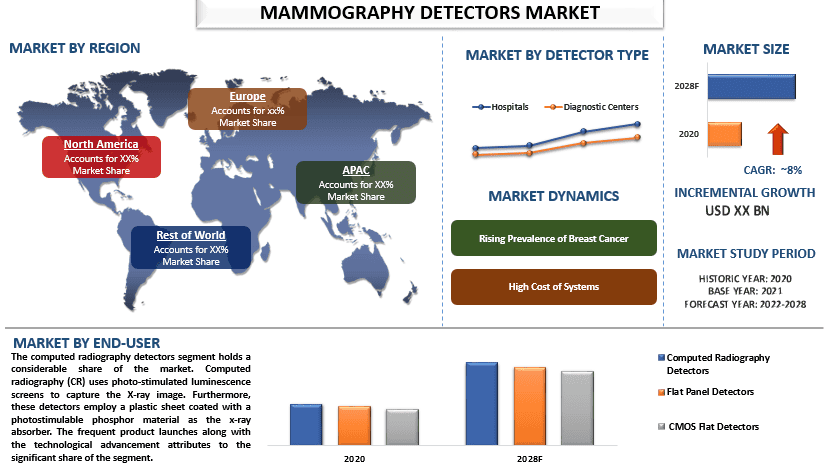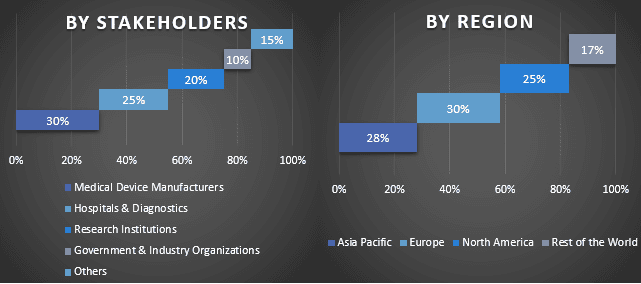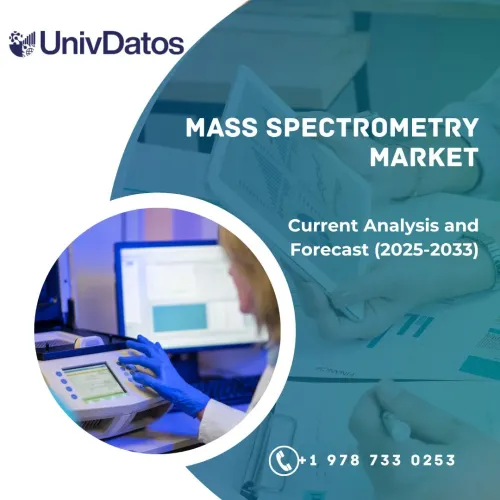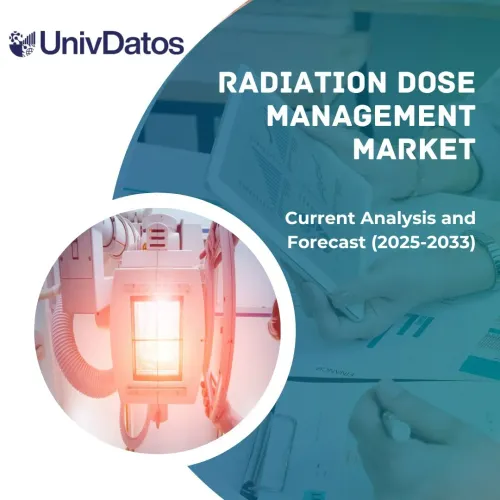- Home
- Chi siamo
- Settore
- Servizi
- Lettura
- Contattaci
Mercato dei rilevatori per mammografia: analisi e previsioni attuali (2022-2028)
Enfasi sul tipo di rilevatore (rilevatori per radiografia computerizzata, rilevatori a pannello piatto e rilevatori piatti CMOS); Utente finale (ospedali e centri diagnostici); Regione (Nord America, Europa, Asia-Pacifico, Resto del mondo); e Regione/Paese

Si prevede che il mercato globale dei rilevatori per mammografia crescerà a un tasso significativo di circa l'8% durante il periodo di previsione.La mammografia è un tipo specifico di imaging mammario che utilizza raggi X a bassa dose per rilevare precocemente il cancro. L'aumento dell'incidenza del cancro al seno, la crescente consapevolezza pubblica della diagnosi precoce della malattia, la crescente domanda di strumenti diagnostici avanzati e gli sviluppi tecnologici nei rilevatori per mammografia sono fattori importanti che contribuiscono alla crescita del mercato dei rilevatori per mammografia.Ad esempio, nel novembre 2022, la Radiological Society of North America (RSNA) ha lanciato la RSNA Screening Mammography Breast Cancer Detection AI Challenge.
Analogic Corporation, General Electric Company, Hologic Inc., Koninklijke Philips N.V., Gamma Medical Inc.., Siemens Healthcare GmbH, SonoCiné, Toshiba Corporation, Teledyne DALSA e Varex Imaging sono alcuni dei principali attori del mercato. Diverse fusioni e acquisizioni insieme a partnership sono state intraprese da questi attori per facilitare i clienti con prodotti/tecnologie hi-tech e innovative.
Approfondimenti presentati nel rapporto
“Tra i tipi di rilevatori, la categoria dei rilevatori piatti CMOS registrerà un CAGR più elevato durante il periodo di previsione”
In base al tipo di rilevatore, il mercato è stato suddiviso in rilevatori per radiografia computerizzata, rilevatori a pannello piatto e rilevatori piatti CMOS. Tra questi, il segmento dei rilevatori piatti CMOS dovrebbe crescere a un ritmo considerevole nel mercato. Il design del sensore CMOS fornisce un nuovo livello di prestazioni e affidabilità per i sistemi a raggi X utilizzati in mammografia. I rilevatori CMOS sono flessibili, stabili, sensibili e più veloci, producendo immagini a più alta risoluzione. La crescente domanda di apparecchiature tecnologicamente avanzate e la flessibilità e la stabilità fornite dai rilevatori piatti CMOS sono i fattori trainanti per l'area segmentale durante il periodo di previsione.
“Tra gli utenti finali, il segmento dei centri diagnostici deterrà un CAGR più elevato durante il periodo di previsione”
In base all'utente finale, il mercato è stato suddiviso in ospedali e centri diagnostici. Tra questi, il segmento dei centri diagnostici dovrebbe crescere a un CAGR significativo durante il periodo di previsione. I centri diagnostici sono stati utili in situazioni che coinvolgono malattie croniche in quanto sono importanti per la prevenzione, l'identificazione e la gestione delle malattie influenzando l'appropriata presa di decisioni cliniche.
“L'Asia-Pacifico assisterà alla crescita più rapida del mercato”
Si prevede che l'Asia-Pacifico crescerà al ritmo più veloce durante il periodo di previsione. I principali fattori come l'aumento dei casi di cancro al seno e la crescente ricerca nel settore medico nella regione sono le ragioni importanti per la crescita del mercato nella regione.Ad esempio, il cancro al seno è il cancro più comune che colpisce le donne e, in Giappone, colpisce oltre 90.000 persone ogni anno.
Motivi per acquistare questo rapporto:
- Lo studio include dimensionamento del mercato e analisi delle previsioni validate da esperti chiave del settore autenticati.
- Il rapporto presenta una rapida panoramica delle prestazioni complessive del settore a colpo d'occhio.
- Il rapporto copre un'analisi approfondita dei principali attori del settore con particolare attenzione ai principali dati finanziari aziendali, al portafoglio prodotti, alle strategie di espansione e agli sviluppi recenti.
- Esame dettagliato di driver, restrizioni, tendenze chiave e opportunità prevalenti nel settore.
- Lo studio copre in modo completo il mercato in diversi segmenti.
- Analisi approfondita a livello regionale del settore.
Opzioni di personalizzazione:
Il mercato globale dei rilevatori per mammografia può essere ulteriormente personalizzato in base alle esigenze o a qualsiasi altro segmento di mercato. Oltre a ciò, UMI comprende che potresti avere le tue esigenze aziendali, quindi non esitare a contattarci per ottenere un rapporto che soddisfi completamente le tue esigenze.
Indice
Metodologia di ricerca per l'analisi del mercato dei rilevatori per mammografia (2022-2028)
L'analisi del mercato storico, la stima del mercato attuale e la previsione del mercato futuro del mercato globale dei rilevatori per mammografia sono stati i tre passaggi principali intrapresi per creare e analizzare l'adozione dei rilevatori per mammografia nelle principali regioni a livello globale. È stata condotta un'esauriente ricerca secondaria per raccogliere i numeri storici del mercato e stimare le dimensioni attuali del mercato. In secondo luogo, per convalidare questi approfondimenti, sono state prese in considerazione numerose scoperte e ipotesi. Inoltre, sono stati condotti anche esaurienti colloqui primari, con esperti del settore in tutta la catena del valore del mercato globale dei rilevatori per mammografia. Dopo l'ipotesi e la convalida dei numeri di mercato attraverso colloqui primari, abbiamo impiegato un approccio top-down/bottom-up per prevedere le dimensioni complete del mercato. Successivamente, sono stati adottati metodi di scomposizione del mercato e triangolazione dei dati per stimare e analizzare le dimensioni del mercato dei segmenti e dei sottosegmenti del settore di riferimento. La metodologia dettagliata è spiegata di seguito:
Analisi delle dimensioni storiche del mercato
Fase 1: studio approfondito delle fonti secondarie:
È stato condotto uno studio secondario dettagliato per ottenere le dimensioni storiche del mercato del mercato dei rilevatori per mammografia attraverso fonti interne all'azienda comerapporti annuali e rendiconti finanziari, presentazioni sulle prestazioni, comunicati stampa, ecc.,e fonti esterne tra cuiriviste, notizie e articoli, pubblicazioni governative, pubblicazioni dei concorrenti, rapporti settoriali, database di terze parti e altre pubblicazioni credibili.
Fase 2: segmentazione del mercato:
Dopo aver ottenuto le dimensioni storiche del mercato del mercato dei rilevatori per mammografia, abbiamo condotto un'analisi secondaria dettagliata per raccogliere approfondimenti storici sul mercato e quote per diversi segmenti e sottosegmenti per le principali regioni. I principali segmenti sono inclusi nel rapporto come tipo di rilevatore e utente finale. Ulteriori analisi a livello di paese sono state condotte per valutare l'adozione complessiva dei modelli di test in quella regione.
Fase 3: analisi dei fattori:
Dopo aver acquisito le dimensioni storiche del mercato di diversi segmenti e sottosegmenti, abbiamo condotto un dettagliatoanalisi dei fattoriper stimare le dimensioni attuali del mercato del mercato dei rilevatori per mammografia. Inoltre, abbiamo condotto un'analisi dei fattori utilizzando variabili dipendenti e indipendenti come il tipo di rilevatore e l'utente finale dei rilevatori per mammografia. Un'analisi approfondita è stata condotta per gli scenari della domanda e dell'offerta considerando le principali partnership, fusioni e acquisizioni, l'espansione aziendale e i lanci di prodotti nel settore dei rilevatori per mammografia in tutto il mondo.
Stima e previsioni delle dimensioni attuali del mercato
Dimensionamento del mercato attuale:Sulla base di approfondimenti attuabili dai 3 passaggi precedenti, siamo giunti alle dimensioni attuali del mercato, ai principali attori nel mercato globale dei rilevatori per mammografia e alle quote di mercato dei segmenti. Tutte le quote percentuali richieste, le suddivisioni e le scomposizioni del mercato sono state determinate utilizzando l'approccio secondario sopra menzionato e sono state verificate attraverso colloqui primari.
Stima e previsioni:Per la stima e le previsioni del mercato, sono stati assegnati pesi a diversi fattori, inclusi driver e tendenze, restrizioni e opportunità disponibili per le parti interessate. Dopo aver analizzato questi fattori, sono state applicate tecniche di previsione pertinenti, ovvero l'approccio top-down/bottom-up, per arrivare alle previsioni di mercato per il 2028 per diversi segmenti e sottosegmenti nei principali mercati a livello globale. La metodologia di ricerca adottata per stimare le dimensioni del mercato comprende:
- Le dimensioni del mercato del settore, in termini di ricavi (USD) e il tasso di adozione del mercato dei rilevatori per mammografia nei principali mercati a livello nazionale
- Tutte le quote percentuali, le suddivisioni e le scomposizioni dei segmenti e dei sottosegmenti di mercato
- I principali attori nel mercato globale dei rilevatori per mammografia in termini di prodotti offerti. Inoltre, le strategie di crescita adottate da questi attori per competere nel mercato in rapida crescita
Convalida delle dimensioni e della quota di mercato
Ricerca primaria:Sono state condotte interviste approfondite con i Key Opinion Leaders (KOL) tra cui Top Level Executives (CXO/VP, Responsabile Vendite, Responsabile Marketing, Responsabile Operativo, Responsabile Regionale, Responsabile Paese, ecc.) in tutte le principali regioni. I risultati della ricerca primaria sono stati poi riassunti e sono state eseguite analisi statistiche per dimostrare l'ipotesi dichiarata. I dati della ricerca primaria sono stati consolidati con i risultati secondari, trasformando così le informazioni in approfondimenti utili.
Suddivisione dei partecipanti primari nelle diverse regioni

Ingegneria del mercato
La tecnica di triangolazione dei dati è stata impiegata per completare la stima complessiva del mercato e per ottenere numeri statistici precisi per ogni segmento e sottosegmento del mercato globale dei rilevatori per mammografia. I dati sono stati suddivisi in diversi segmenti e sottosegmenti dopo aver studiato vari parametri e tendenze nelle aree del tipo e dell'area clinica nel mercato globale dei rilevatori per mammografia.
L'obiettivo principale dello studio sul mercato globale dei rilevatori per mammografia
Le attuali e future tendenze del mercato globale dei rilevatori per mammografia sono state individuate nello studio. Gli investitori possono ottenere informazioni strategiche per basare le proprie decisioni di investimento sull'analisi qualitativa e quantitativa eseguita nello studio. Le tendenze attuali e future del mercato hanno determinato l'attrattiva complessiva del mercato a livello regionale, fornendo una piattaforma per i partecipanti industriali per sfruttare il mercato inesplorato e beneficiare di un vantaggio del first-mover. Altri obiettivi quantitativi degli studi includono:
- Analizzare le dimensioni attuali e previste del mercato dei rilevatori per mammografia in termini di valore (USD). Inoltre, analizzare le dimensioni attuali e previste del mercato dei diversi segmenti e sottosegmenti
- I segmenti nello studio includono le aree del tipo di rilevatore e dell'utente finale.
- Definizione e analisi del quadro normativo per l'industria dei rilevatori per mammografia.
- Analizzare la catena del valore coinvolta con la presenza di vari intermediari, insieme all'analisi dei comportamenti dei clienti e dei concorrenti del settore.
- Analizzare le dimensioni attuali e previste del mercato dei rilevatori per mammografia per le principali regioni.
- I principali paesi delle regioni studiate nel rapporto includono Asia Pacifico, Europa, Nord America e Resto del mondo.
- Profili aziendali del mercato dei rilevatori per mammografia e le strategie di crescita adottate dagli operatori del mercato per sostenersi nel mercato in rapida crescita
- Analisi approfondita del settore a livello regionale
Correlati Report
I clienti che hanno acquistato questo articolo hanno acquistato anche










